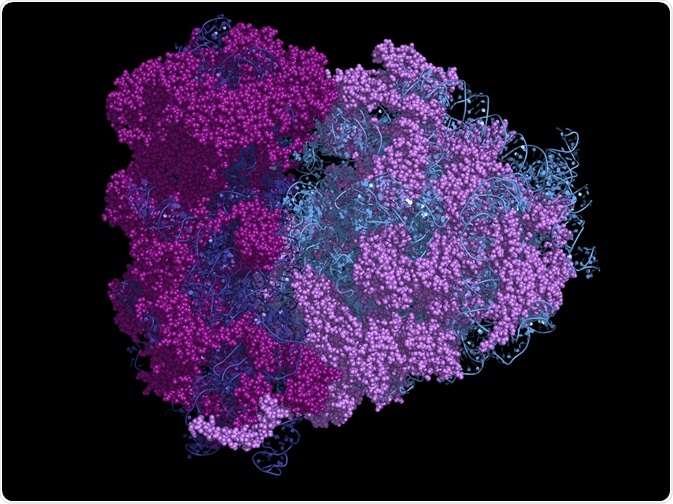Protein degradation
Cellular levels of proteins are not only determined by the process of protein synthesis, but also by rates of protein degradation.
Protein degradation is the process by which protein is broken down into smaller components by one of two pathways, either by the ubiquitin-proteasome pathway or by the method of lysosomal proteolysis.

Image Credit: petarg/Shutterstock.com
The process of protein degradation is not standard across all proteins, as some break down fairly quickly, in just a few minutes, while others take several days to complete this process.
These varying half-lives of different proteins are an essential factor in the regulation of the cellular environment. Many transcription factors and other important regulatory molecules are proteins that have rapid degradation rates. The speed at which they break down is vital to their ability to respond quickly to external stimuli.
Another role of rapidly degrading proteins is to respond to certain signals and regulate intracellular enzyme activity. Also, protein degradation can be initiated as a method of protecting cells from the effects of faulty or damaged proteins.
These molecules are recognized and targeted, with degradation rapidly beginning and clearing the cell of these unwanted proteins.
In human cells and other eukaryotic cells, the ubiquitin-proteasome pathway and lysosomal proteolysis are the two major pathways that regulate the processes of protein degradation. We discuss both of these in detail below.
The Ubiquitin-Proteasome Pathway
The ubiquitin-proteasome pathway is the main pathway regulating the degradation of protein in eukaryotic cells. It uses ubiquitin as a marker and initiates proteolysis in cytosolic and nuclear proteins.
Ubiquitin attaches itself to the lysine residue via the amino group of the side chain, where further ubiquitins are then added to create a multiubiquitin chain.
These polyubiquitinated proteins are then identified by the proteasome which then initiates the degradation process. The ubiquitin that was attached to the proteins is not broken down, as it is released to be reused in another cycle. This process is powered by ATP, the energy source of the cell.
Ubiquitination can serve as a marker of protein stability. The addition of ubiquitins to proteins happens in several distinct steps. The identification of these steps can advise on the protein’s stability.
The first stage involves the activation of ubiquitin as it becomes attached to E1, the ubiquitin-activating enzyme. Then, ubiquitin is transferred to the ubiquitin-conjugating enzyme, E2. Finally, ubiquitin transfer to the target protein is carried out with the help of the ubiquitin ligase or E3.
In most cells, there is a single E1 enzyme, but many E2s and E3s. These different E2 and E3 enzymes recognize different proteins.
Proteins that regulate gene expression, cell proliferation, and other fundamental processes of the cell, are regulated by ubiquitination and subsequent proteolysis. Cyclins are proteins that regulate the progression of the cell division cycle.
Cyclin B, which is a regulatory subunit of Cdc2, mediates the initiation of mitosis in all eukaryotic cells. This process is an example of controlled degradation. Cdc2 kinase is only activated once cyclin B is associated with Cdc2. This activation initiates mitotic events, such as the breakdown of the nuclear envelope and chromosome condensation.
Cdc2 is also responsible for activating the degradation of cyclin B at the end of mitosis via initiating a ubiquitin-mediated proteolysis system. Once cyclin B is broken down, Cdc2 becomes inactivated, and mitosis ends, allowing interphase to begin.
Lysosomal Proteolysis
Lysosomal uptake of proteins represents the other major pathway of protein degradation in humans.
This form of protein breakdown is initiated by the lysosomes, which exist within the cells and have many enzymes contained within their membranes, including multiple kinds of proteases. They are responsible for the digestion of extracellular proteins, the turnover of cytosolic proteins and cytoplasmic organelles, and other processes of cell metabolism.
The presence of proteases and other digestive enzymes inside lysosomes inhibits uncontrolled degradation of the contents of the cell. Therefore, cellular proteins must first be taken up by lysosomes to be degraded by lysosomal proteolysis.
Lysosomes can uptake proteins in two ways. The first involves the formation of autophagosomes that transport the proteins to the lysosome. When the autophagosomes come into contact with the lysosomes, the autophagosomes fuse with lysosomes, and the digestive enzymes enter the autophagosomes, destroying their contents.
This process usually occurs to break down long-lived cytoplasmic proteins as this process is non-selective.
The other way lysosomes can break down proteins is selective. Under cell starvation conditions, lysosomes can take up specific proteins in a selective manner to degrade them.
In this case, the proteins broken down can be targeted by the lysosome because they contain sequences of amino acids similar to the broad consensus sequence.
A molecular chaperone is also utilized in this process to unfold the polypeptide chains, as they are transported across the membrane of the lysosome.
Proteins that are broken down in this manner are usually long-lived dispensable proteins. Under conditions of starvation, proteins are broken down to produce amino acids and energy, fueling basic metabolic processes so that the body can continue to function.
Sources:
- Lecker, S., Goldberg, A. and Mitch, W. (2006). Protein Degradation by the Ubiquitin-Proteasome Pathway in Normal and Disease States. Journal of the American Society of Nephrology, 17(7), pp.1807-1819. https://jasn.asnjournals.org/content/17/7/1807
- Pham, V., Anania, V., Phung, Q. and Lill, J. (2014). Complementary Methods for the Identification of Substrates of Proteolysis. Regulated Cell Death Part A: Apoptotic Mechanisms, pp.359-380. https://www.sciencedirect.com/science/article/pii/B9780124171589000145
- The Cell: A Molecular Approach. 2nd edition. Available at: https://www.ncbi.nlm.nih.gov/books/NBK9957/
- Varshavsky, A. (2001). Proteolysis. Encyclopedia of Genetics, pp.1573-1575. https://www.sciencedirect.com/science/article/pii/B0122270800010417
Further Reading
Last Updated: Sep 2, 2022